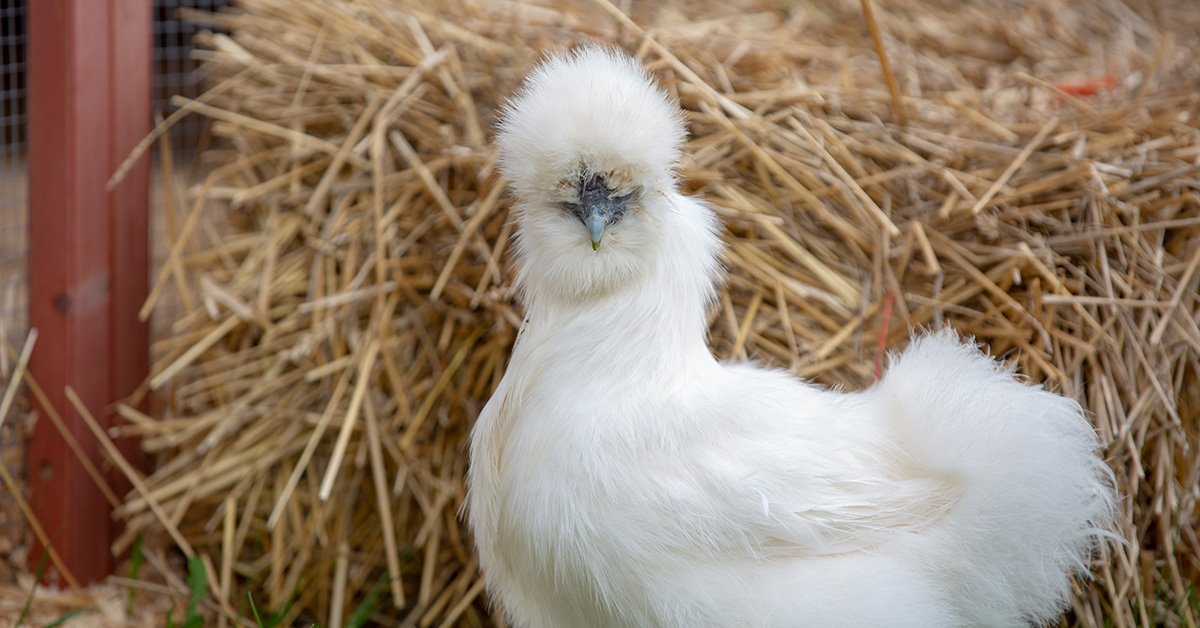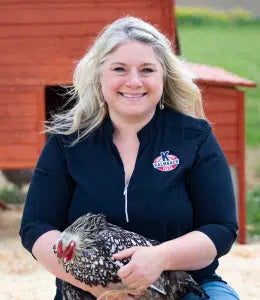The Ins and Outs of Feeding Silkies

Do Silkies need a specialized diet? That can be a complicated question and the answer often depends on your goals for the Silkies in your flock. Silkies can make a fun addition to any poultry flock. They are calm and friendly birds covered in fluffy, unique feathers. However, due to some quirks in their behavior and their quiet demeanor, some additional knowledge is required if you want to add Silkies to your flock.
Do Silkies Need a Specialized Diet?
In most backyard flocks, Silkies do not need a specialized diet and can eat the same high-quality feed that you would choose for other breeds in your flock. Silkies are true bantams and due to their small size, they will often eat less than larger-bodied birds. The average intake for an adult Silkie is around 1/8 to ¼ lb of feed per bird per day. Larger-bodied standard chicken breeds will eat about ¼ to ½ lb of feed per bird per day, depending on season and foraging activity.
Breeding Silkies and Show Silkies
There are some factors that can influence which feed you choose for your Silkies. First, are your Silkies part of a breeder flock? Second, do you plan to show your Silkies? If the answer to either of these questions is YES, then it is very common for a poultry owner to choose a higher crude protein (CP) feed for their Silkies.
Hens that go broody – and Silkies go broody a lot! – will significantly reduce their feed intake during their broody period. This reduced intake coupled with the naturally lower feed intake of Silkies means that a higher CP feed will provide more grams of overall protein each day. Whether or not you choose a higher CP feed for Silkies really depends on how often your girls go broody, how intensive your breeding program is, and whether or not you are trying to maximize feather plumage for shows.
The Roll of Selenium and Vitamin E in Poultry Nutrition
You may often read that Silkies require higher levels of selenium and Vitamin E. Selenium, a trace mineral, and Vitamin E, a fat-soluble vitamin, work together as antioxidants to prevent damage to cells in the body. Vitamin E is also a very important nutrient required for proper immune function.
Because we know these nutrients are essential to proper chicken health, that can lead some people to believe that “more must be better.” However, there is definitely a sweet spot with any supplementation of a vitamin or mineral. More is not always better.
Selenium supplementation in animal feed is highly regulated. The Food and Drug Administration (FDA) caps the amount of selenium that any feed company can add to a complete poultry feed at 0.3 ppm. That is the maximum allowable amount of selenium that can be safely added to any complete poultry feed. Supplementation with any product containing selenium should be closely monitored and care should be taken to avoid selenium toxicity in your chickens. Signs of selenium toxicity include reduced growth and decreased hatchability in fertilized eggs.
Vitamin E is a fat-soluble vitamin. This means that Vitamin E requires fat in order be absorbed in the intestine and extra Vitamin E can be stored in fat and other tissues for future use. Unlike water-soluble vitamins, which are excreted if an animal consumes too much, fat-soluble vitamins can build up in tissues where those vitamins are stored. This storage component is handy for future use, but we have to be careful with over-supplementation of fat-soluble vitamins. Very high levels of Vitamin E can result in reduced weight gain, poor feather appearance, and decreased livability in hatched chicks.
Special note – when reviewing any concentration of minerals and/or vitamins, it is very important to pay attention to the unit of measure. For example, vitamins are required to be listed on a feed tag as IU/lb but lots of online information will list vitamins as IU/kg. Make sure you consider this factor when reviewing and comparing product information.
What Feed Should I Choose for my Silkies?
For young Silkie chicks in most backyard flocks, a high-quality starter/grower feed, like 20% Flock Maker®, is an excellent option from hatch until laying age. Once your Silkies are old enough to switch to layer feed, look for a high-quality layer feed that has a great balance of nutrients. If you are looking for a feed with a combination of whole grains, seeds, and vegetables, consider Henhouse Reserve®. This feed is a 17% CP and the perfect option for flocks with roosters in the mix.
If you are interested in higher CP feeds, our 20% CP Full Plume® Feathering Feed and Formula of Champions® 22% CP Fancy & Feathered®, are very popular options for show birds. Both options are smaller mini pellets, which are desirable to many bantam owners!
Whatever option you choose, make sure to look for a feed company that puts quality first. Silkies tend to be finicky chickens and do best when offered a consistent diet. Look for a product that is fixed formulation and consistent quality every time, like Kalmbach Feeds®.
Keeping poultry is such a wonderful experience and the rewards are many! At Kalmbach Feeds®, we are always here to help. If you have any questions about the nutrient needs of your birds, feed options, or general poultry keeping, please let us know. We are so excited to continue writing about all of the topics that are important to you and can’t wait to continue learning about your flocks. Stay tuned and thank you for choosing Kalmbach Feeds®!
